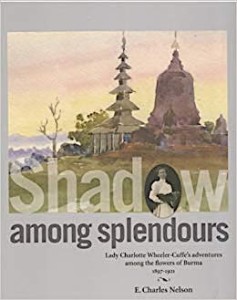 During her twenty-four years in Burma with her husband, an engineer in government service, Lady Charlotte Wheeler-Cuffe (nee Williams) became an intrepid plant-hunter, whose discoveries included various species of rhododendron. On her husband’s retirement in 1922 the couple retired to his ancestral seat at Lyrath, near Kilkenny, and it was here that Lady Charlotte planted some of the exotic plants she had gathered over the years. While in Burma Lady Charlotte had corresponded with friends, including another keen plantswoman, Baroness Prochaya, who also lived at Lyrath and professional botanists, one of whom was Frederick Moore, head of the Botanic Gardens at Glasneven, near Dublin, and on her return to Ireland it would seem that the correspondence continued.
During her twenty-four years in Burma with her husband, an engineer in government service, Lady Charlotte Wheeler-Cuffe (nee Williams) became an intrepid plant-hunter, whose discoveries included various species of rhododendron. On her husband’s retirement in 1922 the couple retired to his ancestral seat at Lyrath, near Kilkenny, and it was here that Lady Charlotte planted some of the exotic plants she had gathered over the years. While in Burma Lady Charlotte had corresponded with friends, including another keen plantswoman, Baroness Prochaya, who also lived at Lyrath and professional botanists, one of whom was Frederick Moore, head of the Botanic Gardens at Glasneven, near Dublin, and on her return to Ireland it would seem that the correspondence continued.
This typewritten letter dated August 1923, which we found in the Jot 101 archive, seems to have been unposted, as it contains corrections in ink and lacks the name of the intended recipient, is addressed to a botanist from Horsham who was writing a book. In the letter she reports that she had just sent this botanist a blossom of Lilium lowii, which she had originally discovered nearly eight years earlier:
‘ In November 1915 I was travelling with my husband…in the Southern Shan States and finding some dried stalks and seed pods of a lily (growing on the edge of a wood and facing north, on limestone, at an elevation of somewhere about 5,000 ft) dug them up and brought them back to Maymyo, where we were stationed. There they flowered the following summer, and next autumn I sent some of them home to Glasneven, where Sir F Moore had always been most kind and helpful to me in my amateurish efforts at plant collecting …Sir Frederick wrote to me the next year saying that the lilies were L.lowii, which had been in cultivation in Europe but lost for many years, as its habitat was not known. The first place I found it was near Loilem (lat.20, long 20), but I afterwards discovered it in many other similar places and got quite a lot of bulbs into the Botanical Garden at Maymo, the summer headquarters of the Burma Govt., where I worked during the war.
This lily and L.sulphureumoften grow naturally together, in open woodland in the Shan hills; and in damper places a yellow and brown one, which I believe to be L.nepalensis. I have watercolour drawings of both these, if you would care to see them. Other lilies I have found in Burma are: a beautiful pure white one, growth like sulphureum but quite different bulb ( small and white, whereas sulphureum is large and purplish).This white lily grows in the extreme north eats of Burma, on the China frontier at about 6,000 feet and further up the passes ( about 11,000 ft) there is a lovely spotted pink and white lily which was, I think, first found by Miss Malet, who was up at the frontier post of Hpimaw with her brother. ( she sent it to me at Maymo and I had it blossoming there a year at least before Mr Farrer found it ; but I believe it has been named Nomocharis farreri).Mr Kingdom Ward found a beautiful crimson lily on Imaw Bum , a 13,000ft. mountain near Hpimaw; and I got a lovely flaming scarlet one in the Ruby Mines district, but failed to bring it home. It was very similar to the scarlet Korean lily and may have been imported via China, as it was in a village and the Lashi people eat the bulb. There is another edible lily bulb in the Chin Hills with a white blossom: but this I have not seen as I was only there in early spring, but I hope to get some bulbs sent home this winter.’
CHARLOTTE I. WHEELER CUFFE
P.S. L.lowiivaries much in marking and there is a pure white form.
Lady Charlotte died in 1967, aged ninety-nine, a passionate plantswoman to the end. Today the mansion at Lyrath is a very exclusive hotel surrounded by the wonderful gardens that she helped create.
R.M.Healey
